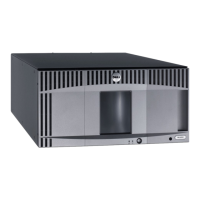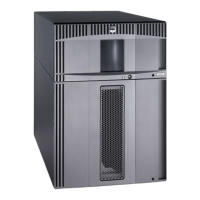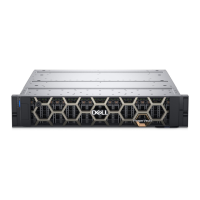Configuring Your Library
file:///T|/htdocs/stor-sys/ML6000/en/html/ch04.htm[9/17/2012 1:49:29 PM]
Configuring FC I/O Blade Ports
When FC I/O blades are installed, administrators can configure FC I/O blade port parameters.
Each FC I/O blade has six ports. Ports 1 and 2 are always target ports and are configurable. Ports 3 through 6 are always
initiator ports and are not configurable. For information on viewing the current configured settings for all I/O blade ports, see
Viewing FC I/O Blade Port Information.
Details on configuring FC I/O blade ports include:
• The Setup - I/O Blade Port Configuration screen lists all I/O blades found in the library. The screen lists the
following information for each I/O blade: location in the library, World Wide Node Name (WWNN), status, and ports.
You can select the I/O blade target port (1 or 2) you want to configure and proceed to the next screen. For the target
port you selected, the screen displays the World Wide Port Number (WWPN).
• For the selected target port (ports 1 and 2), you can configure the following parameters:
• Loop ID — Loop IDs can be set to Auto or a hard value from 0 through 125. Selecting Auto automatically selects
a unique loop ID. Some FC host operating systems require hard loop ID settings. The default setting is Auto.
• Speed — The interface speed can be set to Auto, 1 Gb/s, 2 Gb/s, or 4 Gb/s. Selecting Auto automatically sets
the interface speed. The default setting is Auto.
• Frame Size — Frame size can be set to 512, 1024, or 2048. The default setting for ports 1 and 2 is 2048. Your
FC host might require a different setting.
• Connection — The connection mode for the ports can be set to Loop, Loop Preferred, or Point to Point. The
default setting is Loop Preferred.
• After modifying these parameters, save the library configuration. For instructions on how to save the library
configuration, see
Saving and Restoring the Library Configuration.
The paths to open the appropriate screens are as follows:
• From the Web client, select Setup > I/O Blades > Port Configuration.
• From the operator panel, select Setup > I/O Blades > Port Configuration.
FC I/O Blade Internal Virtual Port for Medium Changers
FC I/O blades use an internal virtual port to access the medium changer devices (every defined partition has a medium
changer device). Each FC I/O blade can access all medium changer devices, except those that are defined in association with
drive-based access (also known as "LUN-1"). The PowerVault ML6000 library can have up to 18 partitions. These internal
virtual ports are not configurable via channel zoning; thus, all medium changer devices are accessible via ports 1 and 2 of
each FC I/O blade present within the library. This may lead to one or more medium changers being discovered multiple times,
depending on how the system is connected to host servers (for example, if four partitions are defined in a system that has
two FC I/O blades, there would be four medium changers visible on ports 1 and 2 of both FC I/O blades, for a total of 16). To
minimize unnecessary discovery of medium changers, you need to configure host mapping. See
Managing FC Hosts and Host
Mapping.
Configuring FC I/O Blade Channel Zoning
When FC I/O blades are installed in the library, administrators can configure channel zoning for selected I/O blades. Channel
zoning, also called port zoning, configures access to an entire FC and all the LUNs on that channel for the exclusive use of a
host or group of hosts on a single port. Channel zoning enables you to control access between specific target ports 1 and 2
and initiator ports 3–6 on an FC I/O blade.
Note: Channel zoning acts upon the FC tape drive LUNs seen through the initiator ports on the I/O blade. Channel
zoning does not affect medium changer LUNs (partitions). If you want to map hosts to medium changer LUNs though
an FC I/O blade, you must use the FC I/O blade's FC host mapping feature. For information on FC host mapping, see
Managing FC Hosts and Host Mapping.
Note: If both channel zoning and host mapping are enabled, the channel zoning settings supersede any host LUN
mapping on the I/O blade.
Details on configuring channel zoning include:
• By default, all target FC ports (ports 1 and 2) on an FC I/O blade have access to all initiator ports (ports 3–6).

